Additional author: Justin Burt, postdoctoral research associate, Department of Crop and Soil Sciences, University of Georgia Tifton Campus.
A good grazing management plan is essential to producer success for any grazing livestock production system. One of the keys when building a grazing management plan is to have a good understanding of the stocking rate on your farm and how it relates to forage availability. For more information on determining forage availability, please review UGA Extension Bulletin 1567, How to Use a Grazing Stick.
Stocking Rate vs. Stocking Density
Stocking rate is the number of animals being grazed within a given system (e.g., usually a single farm) over a defined period. This should not be confused with stocking density, which refers to the number of animals having access to a particular paddock or field at a particular time. Stocking rate typically refers to an entire farm, while stocking density is used to describe a specific pasture or section of a pasture at a specific time. This is detailed in the example below and in Figure 1. Stocking rate decisions should be made based on forage availability. When making these stocking decisions, it is important to know when to start and stop grazing.
How to Calculate Stocking Rate
Stocking rate is calculated using the following equation:
Stocking density is calculated using the following equation:
Example: Assume you have a 60-acre farm and a herd with 15 cows managed under continuous stocking (i.e., continuous grazing). This translates to a stocking rate of 4 acres/cow (Figure 1). Since the farm only has one pasture, the stocking density of this pasture is also 4 acres/cow. When a farm has continuous stocking, the stocking rate always equals the stocking density.
Now, what if the same 60-acre farm was divided into four pastures of equal size (i.e., 15 acres each) and rotationally stocked (i.e., rotationally grazed)? There are now 15 cows on 15 acres at any one time. The stocking rate is still 4 acres/cow, but the stocking density is now one cow/acre or 1 acre/cow (Figure 1). The stocking density is determined by the defined pasture area at a specific point in time. Under rotational management, the stocking rate and density should increase over time to be greater than continuous grazing because of improved forage utilization and rest periods for the forage. This is only possible if the animals will be rotating to another field when the available forage is depleted.
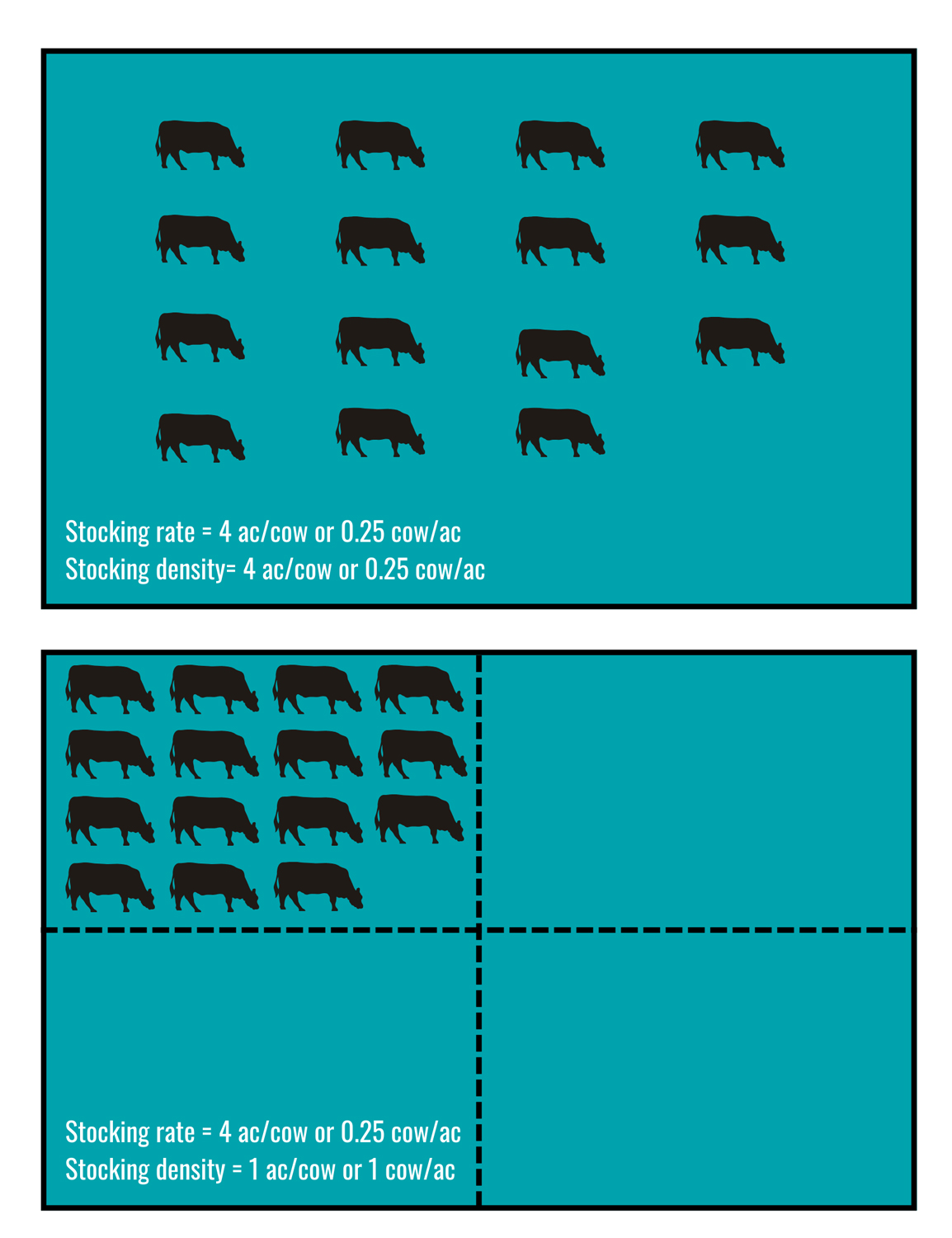
How to Determine the Number of Animal Units
Since different animals vary in size and weight, stocking rates calculated using animal units equivalent (AUE) is more accurate than using a count of the number of animals. Typically, one AUE is defined as a mature, nonlactating (i.e., dry) cow weighing 1,000 lb, fed at a maintenance level. Thus, a cow weighing 1,000 lb = 1 AUE. If you have a 700 lb animal it is equal to 0.7 AUE, and a 1,200 lb animal is 1.2 AUE. A 1,100 lb cow and her 300 lb calf are equal to 1.4 AUE. Figure 2 and Table 1 illustrate the various AUE for various classes and species of livestock.
To determine what the actual AUE is, use the following equation:
Example: Assume you have 15 dry cows that weigh 1,200 lb each. Using the previous equation for determining AUE, one AU (cow) is 1.2 AUE. Multiply 15 cows by 1.2 AUE and the result is 18 AUE total.
AUE = 1.2
If these cows are grazing 60 acres of mixed warm-season perennial pastures, then the stocking rate is 60 acres divided by 18 AUE, which is equal to 3.3 acres/AUE.
Stocking rate = 3.3 acres/AUE
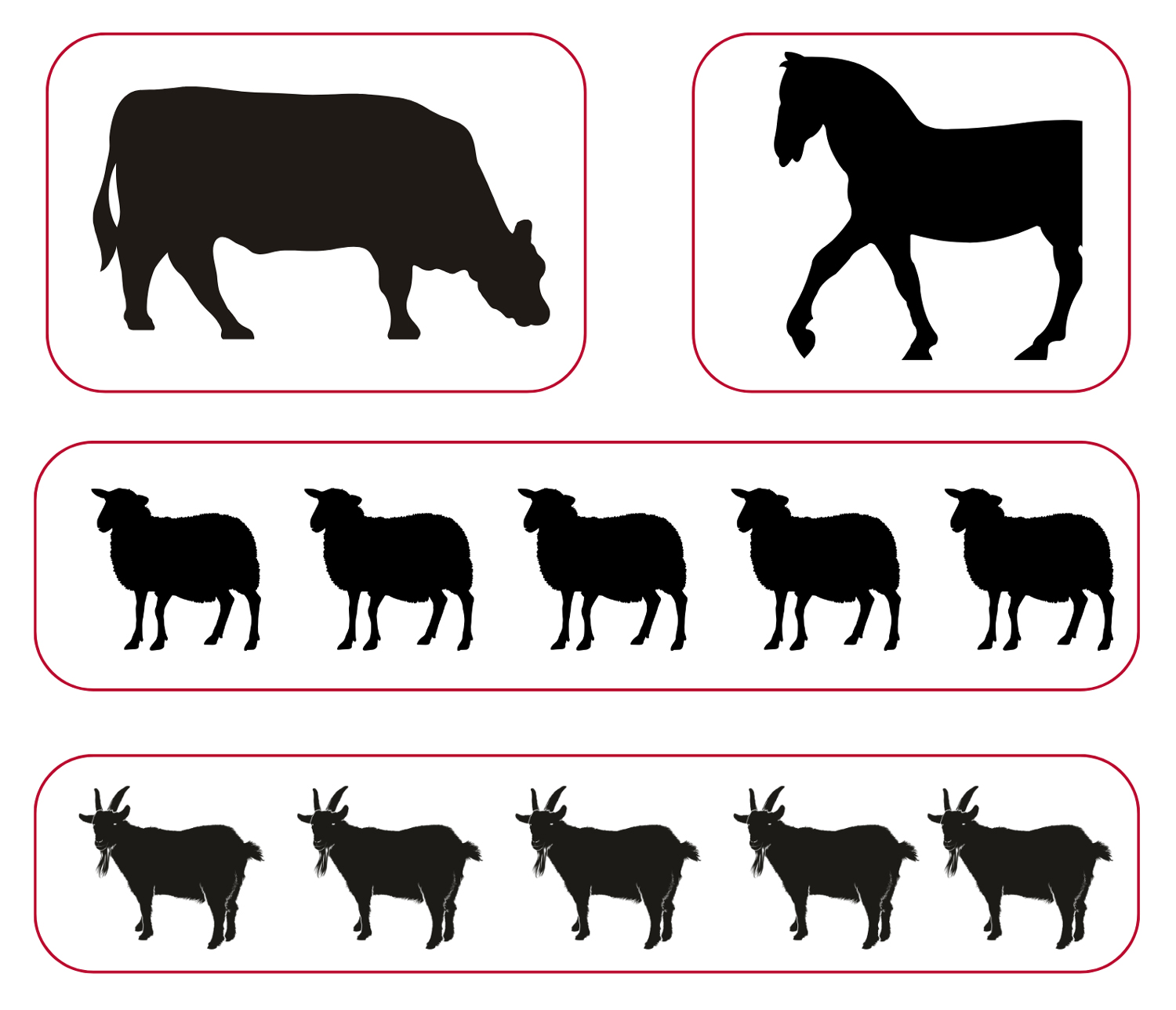
| Class of Animal | AUE |
|---|---|
| Cow, dry | 1.00–1.50 |
| Cow with calf | 1.20–1.60 |
| Bull, mature | 1.25–1.75 |
| Calf, weaned | 0.50–0.70 |
| Steer/heifer, 18 months | 0.80–1.00 |
| Sheep, mature ewe or ram | 0.20–0.30 |
| Sheep, yearling | 0.15–0.20 |
| Goat | 0.17–0.20 |
| Horse, mature | 1.25–2.00 |
Maintaining the appropriate stocking rate for your farm ensures that forage utilization, animal production, and system (i.e., farm) production are optimized (Figure 3). This results in the best utilization of available forage resources across the entire farm. Under this scenario, average daily gain (ADG) of individual animals is not maximized, since the goal is to instead increase the total number of animals achieving higher liveweight gain or product produced per acre (lb/acre), not just the productivity of a single animal. The stocking rate at which animal performance goals are achieved while still maintaining the integrity of the forage resource base is often referred to as the carrying capacity of a system or unit.
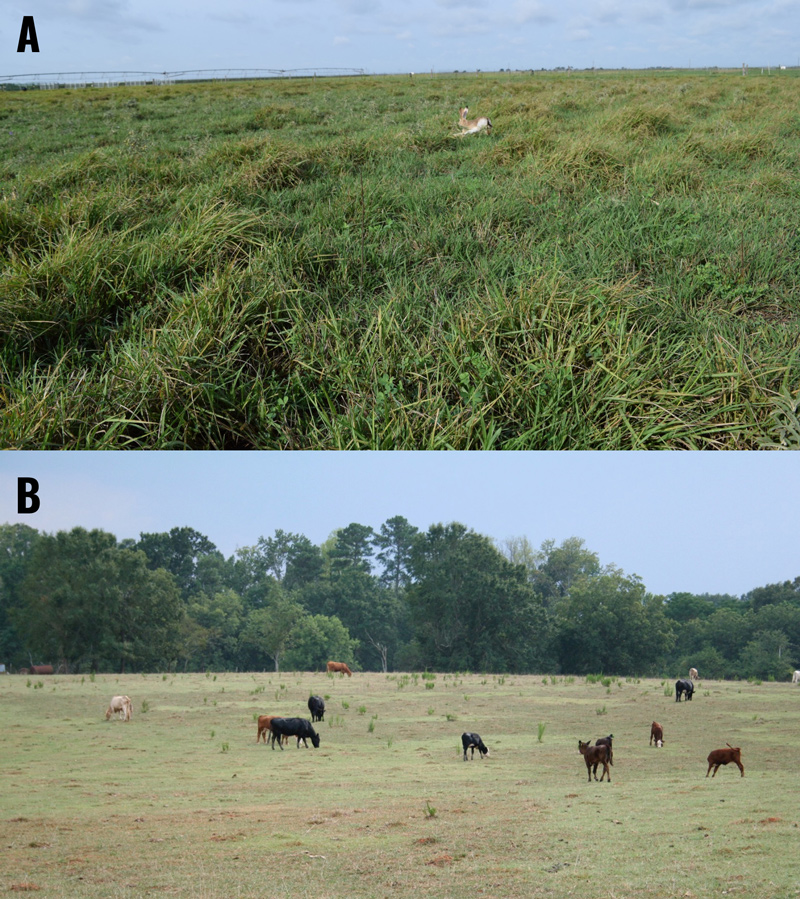
Ideally, stocking rates should vary throughout the year in order to best match available forage resources with the forage demand of the grazing animals. For example, during calving time, your cows will have a higher forage demand, so this should be timed for when there is plenty of actively growing forage. Alternatively, you could harvest excess forage as hay or baleage during a different time period, which can then be supplemented as needed to maintain optimum forage availability.
Undergrazing occurs when the use of a pasture is lower than the optimal carrying capacity (Figure 3A). When pastures are undergrazed, the forage is poorly utilized, which leads to selective grazing by livestock. This often results in high ADG but low productivity per acre (Figure 4). Overgrazing occurs when the carrying capacity of the forage resource is exceeded continuously. This occurs when there is an overutilization of the forage and the pasture is continuously stocked too close to the ground (Figure 3B). Grazing livestock will stop gaining weight or even begin to lose weight as forage supply declines and remains below what is required to meet the daily feed requirements of the herd or flock (Figure 4).
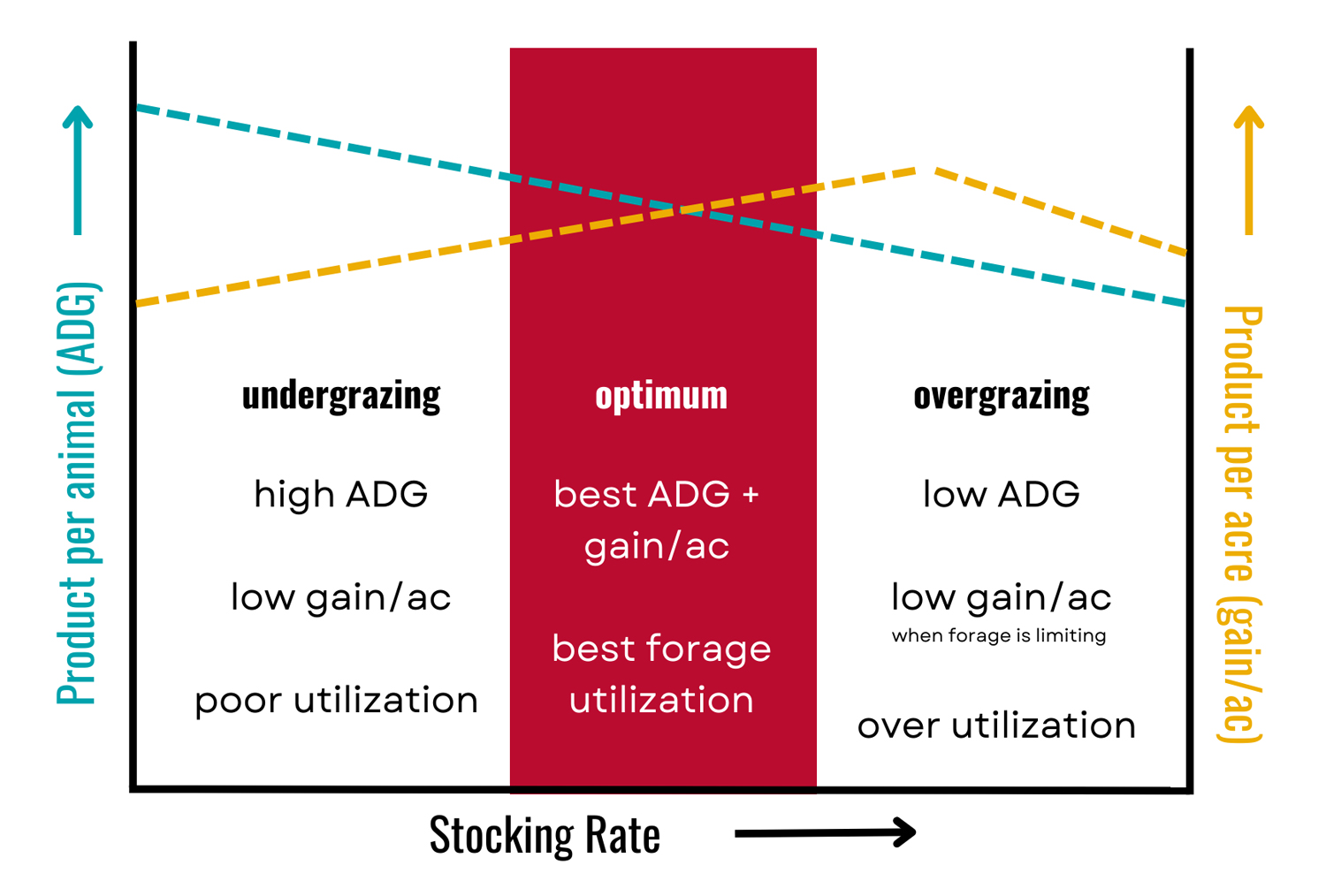
While each farm unit may respond differently to under- or overgrazing, here is a list of common concerns that producers should be familiar with.
Undergrazing
- pastures are not grazed uniformly
- increased instances of selective grazing
- poor nutritive value in forage because of increased plant maturity
Overgrazing
- increased potential for soil erosion
- increased presence of weeds
- decreased preferred forage for grazing
- need for more supplemental feed or stored forage resources
The seriousness of these consequences depends on the severity, duration, frequency, and timing of the under- or overgrazing event. More in-depth information on the impact of grazing livestock on pastures can be found in UGA Extension Bulletin 1243, Grazing Impacts on Pasture Composition.
Continuous Stocking Versus Rotational Stocking Grazing Systems
Continuous stocking, often referred to as continuous grazing, is when there is grazing of only one pasture for an extended period of time (Figure 5). Continuous stocking often results in under- or overgrazing depending on the number of grazing livestock. Rotational stocking or rotational grazing is when a pasture is divided into at least two sections and the animals are moved or rotated throughout each of the sections (Figure 5). Rotational stocking helps optimize forage utilization in a grazing livestock production system and prevents under- or overgrazing. Table 2 lists the pros and cons of continuous and rotational stocking.
| Grazing system | Pros | Cons |
|---|---|---|
| Continuous stocking |
Works well in perennial grass systems; Low labor input; No extra internal fencing required |
Not recommend for annual forages; Overgrazed or undergrazed areas; Animals selectively graze pasture |
| Rotational stocking |
Forage is grazed more uniformly; Works with perennial and annual forages; Improved forage persistence |
More fencing is required; Labor intensive; Longer forage rest periods |
Types of Rotational Stocking
There are many versions of rotational stocking, ranging from low-intensity to very high-intensity management. There is no correct or “textbook” number of animals or paddocks for a given farm. These numbers will depend on your farm’s size, forage health and productivity, desired level of production, number of forage species used, and how intensely you wish to graze the livestock.
There are several types of rotational stocking methods that are used regularly in grazing systems (Figure 5). Rotational grazing systems can have as few as two pastures or sections that the animals rotate between. The ideal number of pastures will depend on the factors listed above. Strip grazing is a type of rotational grazing that can be used in which you allow the livestock to graze a strip of a defined smaller area to efficiently graze the available forage (Figure 5). These sections typically are only large enough to support grazing for 1–2 days before the animals are moved to the next section. This can be accomplished with or without a back fence to restrict grazing to the current section or allow animals to walk back to a central water source.
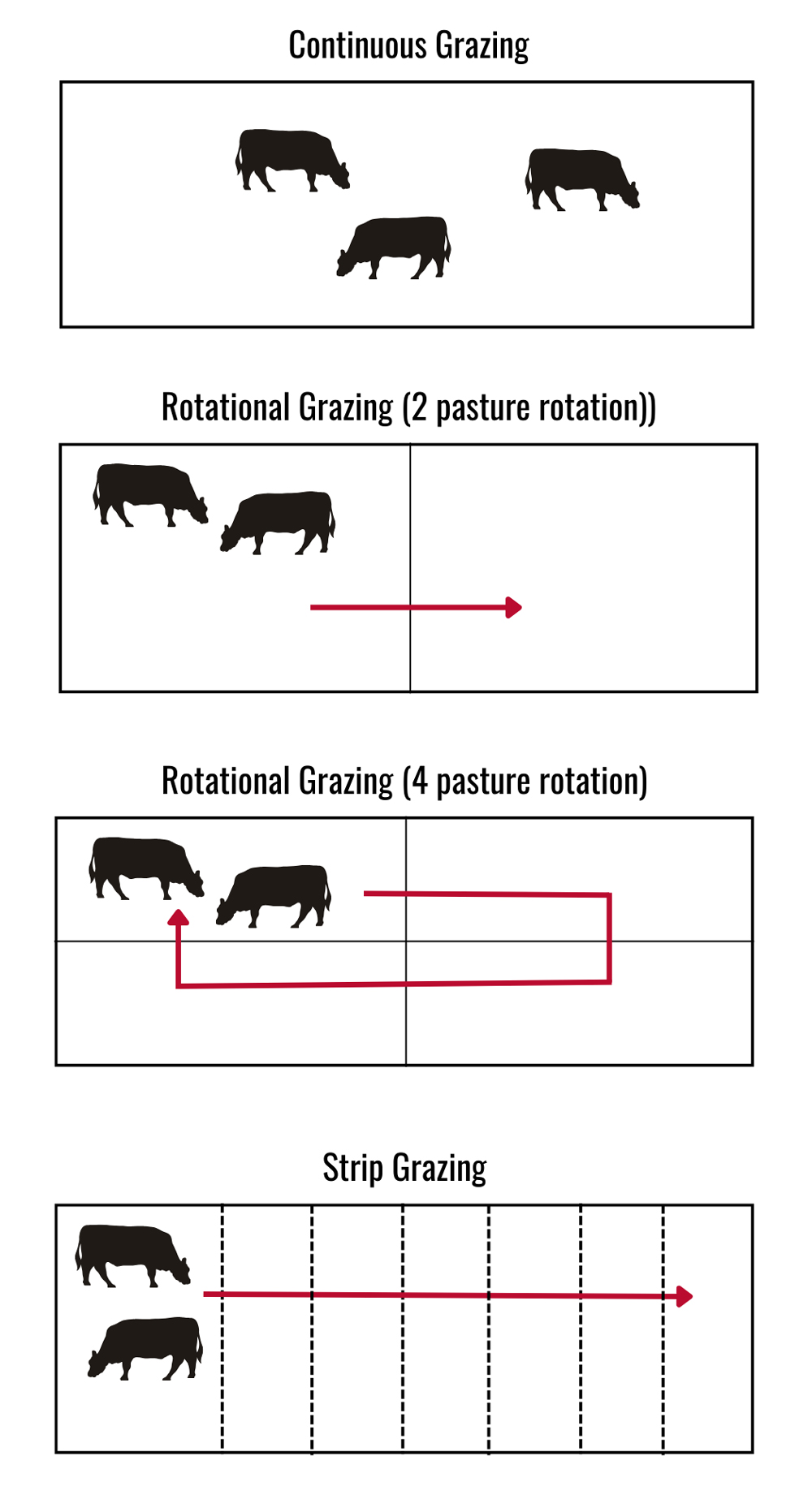
Summary
Stocking rate is a critical factor in all grazing operations, no matter the livestock species. It is important for producers to accurately calculate their stocking rate, so they optimally utilize their forage resources. By accurately determining stocking rate, understanding their grazing management options, and measuring forage availability, producers can develop an effective grazing management plan for their operation. For more information or assistance in making stocking decisions, contact your local Extension office (1-800-ASK-UGA-1, extension.uga.edu).
Acknowledgments
We gratefully recognize the contributions of Dennis W. Hancock and John Andrae for their work on CSS-F017, What is Management-Intensive Grazing (MiG) and What Can It Do for My Farm?
References
Hancock, D. & Andrae, J. (2009). What is management-intensive grazing (MiG) and what can it do for my farm? (Publication No. CSS-F017). University of Georgia Extension. https://sustainagga.caes.uga.edu/content/dam/caes-subsite/sustainable-agriculture/documents/ManagementIntensiveGrazing.pdf
Hancock, D. W., Lacy, R. C., & Stewart, R. L. J. (2014). Forage systems for stocker cattle (Publication No. B 1392). University of Georgia Cooperative Extension. https://extension.uga.edu/publications/detail.html?number=B1392
Morgan, S. (2018). Is your stocking rate correct? UGA Forage Extension Team. https://site.extension.uga.edu/forageteam/2018/06/is-your-stocking-rate-correct/
Status and Revision History
In Review on Aug 13, 2024
Published on Aug 20, 2024


























































